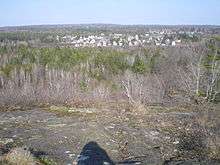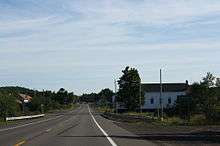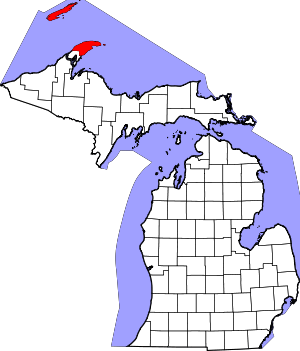Ahmeek, Michigan
| Ahmeek, Michigan | |
|---|---|
| Village | |
|
Hubbell Street, Downtown Ahmeek Village | |
 Location of Ahmeek in Keweenaw County, Michigan | |
| Coordinates: 47°17′54″N 88°23′50″W / 47.29833°N 88.39722°WCoordinates: 47°17′54″N 88°23′50″W / 47.29833°N 88.39722°W | |
| Country | United States |
| State | Michigan |
| County | Keweenaw |
| Area[1] | |
| • Total | 0.07 sq mi (0.18 km2) |
| • Land | 0.07 sq mi (0.18 km2) |
| • Water | 0 sq mi (0 km2) |
| Elevation | 869 ft (265 m) |
| Population (2010)[2] | |
| • Total | 146 |
| • Estimate (2012[3]) | 150 |
| • Density | 2,085.7/sq mi (805.3/km2) |
| Time zone | Eastern (EST) (UTC-5) |
| • Summer (DST) | EDT (UTC-4) |
| ZIP code | 49901 |
| Area code(s) | 906 |
| FIPS code | 26-00620[4] |
| GNIS feature ID | 2397918[5] |
Ahmeek is a village in Keweenaw County in the U.S. state of Michigan. The population was 146 at the 2010 census. The village is in Allouez Township. The name Ahmeek is derived from the Ojibwa (Chippewa) language. In Ojibway, amik means beaver.
Ahmeek is the only incorporated municipality in Keweenaw County.
The Ahmeek Mining Company opened in 1903. The local area grew because of its location on the Mineral Range Railroad.[6] The village itself was founded in 1904 by John Bosch.[7]
History
Copper Country Strike of 1913-1914
During the hate-filled Copper Country Strike of 1913–1914, the village of Ahmeek was the scene of much activity and conflict.
WFM leadership in Ahmeek
Leadership of the Western Federation of Miners (WFM) in the Keweenaw was more nearly indigenous than anywhere else within the strike zone. Sydney Thomas, born in England, and Andrew Pietala, a Finnish socialist, were the president and secretary, respectively, of the Keweenaw WFM local at Ahmeek. But the leaders of the strikers were, in James MacNaughton's description, "an Irish bunch called Dunnigan; they are perfect fire eaters." Patrick "Paddy" Dunnigan and his father, John Dunnigan, were miners. John Dunnigan had, as Paddy said,been elected as the mine inspector in Keweenaw County in opposition to the "bosses' wills." The elder Dunnigan had managed to Ahmeek WFM store, drawing $150 a month for that in addition to his $1,700 yearly pay as mine inspector, WFM critics pointed out. Paddy headed various morning parades by giving "that fire bell a couple of dings" and when the Ahmeek village marshal, Timothy O'Brien, objected, O'Brien was removed from his position. Dunnigan then became the marshal. Village President Morris Kennell was forced to resign. Mike Reilly, Dunnigan's brother-in-law, and then Alfred Haddy, a miner, then succeeded him.[8][9][10][11][12][13]
Violence
On September 29, 1913, a trainload of strikebreakers from the Ascher Detective Agency in New York City was to arrive in Ahmeek, Michigan. Strikers were given fifteen minutes notice "from the railroad" -- most probably in actuality from a WFM sympathizer who worked for it -- that Ascher guards were coming. The strikers hurriedly rushed to set up a barricade before the train bearing the men reached Ahmeek at about 9:30 PM. The train was stopped. A volley of shots exploded. A shower of rocks subsequently followed. The Pullman car's windows were shattered. The train then returned to Calumet. From there, between three and four the next morning, the thirty watchmen were taken by car to the Ahmeek mine, running the gauntlet of a hundred or more rifle shots -- an attempt to halt a necessary operation or sheer cussedness, opined General Perley J. Abbey.[8][14][15][16][17]
On October 23, 1913, Abbey reported that four individuals were arrested near Ahmeek for shooting up "workmen's premises."[18]
On November 27 (Thanksgiving Day), 1913, a smokestack near Ahmeek shafts No. 1 and No. 2 was dynamited. Only the base of the stack was damaged but the explosion, heard for ten miles around, shattered windows in the shaft, compressor, dry, engine, and boiler houses.[8][19][20]
A Keweenaw County jury acquitted a woman, one of two persons who could be identified among a group of individuals who beat Alfred Anderson, an employee of the Ahmeek mine, so badly that his recovery was in doubt for a time.[8]
The raid at Ahmeek

When Paddy Dunnigan of Ahmeek heard of the raid at South Range, he allegedly exclaimed that "we have three-hundred rifles right here and I will be goddamned if any of the officers of Houghton and Keweenaw County can get them without bloodshed, to give them to the Citizens Alliance to shoot the shit out of us." Five days later, Ahmeek, which was at the time often described as "the hotbed of the federation in Keweenaw County," was raided. Militiamen and mounted police cordoned the village during the search. The dragnet only picked up nine riot sticks, two rifles, three shotguns, one revolver, and one-hundred feet of fuse. Except for one shotgun, all of the yield came from saloons that were ran by Joseph Lesh and Frank Malner. The fuse, said Malner, was something he used on his personal farm. The weapons were used for protection. Neither saloonkeeper could explain the presence of the riot sticks. Frustrated officials believed that, in anticipation of the raid, the majority of the weapons in the village had been removed.[8][21][22][23][24][25]
Dunnigan was arrested on a charge by Deputy J.H. Davis of taking a revolver from him several weeks earlier. His bond was set at $500. Joseph Dunnigan, Paddy's eighteen-year-old brother who daily had carried mail from the station to the Ahmeek postoffice, was interrupted that day by the law. He had heard noise at about 7:00 AM and went out into the yard to investigate. There, Marshal Wills collared and detained him within a soldiers' tent until nine o'clock though Dunnigan protested that the mail had to be delivered at 8:20 AM.[8][21][22][23][24][25]
Geography


According to the United States Census Bureau, the village has a total area of 0.07 square miles (0.18 km2), all land.[1]
Based on total area, Ahmeek holds the distinction of being the largest incorporated community, in the largest county (Keweenaw County, 5,965.96 square miles (water and land; Marquette County is largest Michigan county by land area only) in the largest state (Michigan, 96,716.11 square miles), east of the Mississippi River, located within the United States. See County statistics of the United States.
The tip of the Keweenaw is said to be in the Copper Country and on the Copper Island.
The Lower Falls is an area tourist attraction.[6]
Demographics
| Historical population | |||
|---|---|---|---|
| Census | Pop. | %± | |
| 1910 | 766 | — | |
| 1920 | 892 | 16.4% | |
| 1930 | 624 | −30.0% | |
| 1940 | 475 | −23.9% | |
| 1950 | 360 | −24.2% | |
| 1960 | 265 | −26.4% | |
| 1970 | 238 | −10.2% | |
| 1980 | 210 | −11.8% | |
| 1990 | 148 | −29.5% | |
| 2000 | 157 | 6.1% | |
| 2010 | 146 | −7.0% | |
| Est. 2015 | 146 | [26] | 0.0% |
2000 census
As of the census[4] of 2000, there were 157 people, 82 households, and 36 families residing in the village. The population density was 2,237.9 per square mile (866.0/km²). There were 120 housing units at an average density of 1,710.5 per square mile (661.9/km²). The racial makeup of the village was 96.82% White, 0.64% Asian, and 2.55% from two or more races. 29.1% were of Finnish, 19.6% Italian, 12.2% German, 12.2% English and 7.4% French ancestry.
There were 82 households out of which 18.3% had children under the age of 18 living with them, 34.1% were married couples living together, 3.7% had a female householder with no husband present, and 54.9% were non-families. 48.8% of all households were made up of individuals and 23.2% had someone living alone who was 65 years of age or older. The average household size was 1.91 and the average family size was 2.84.
In the village the population was spread out with 19.1% under the age of 18, 3.2% from 18 to 24, 31.2% from 25 to 44, 24.2% from 45 to 64, and 22.3% who were 65 years of age or older. The median age was 43 years. For every 100 females there were 137.9 males. For every 100 females age 18 and over, there were 139.6 males.
The median income for a household in the village was $24,231, and the median income for a family was $33,750. Males had a median income of $21,563 versus $21,250 for females. The per capita income for the village was $16,188. About 8.3% of families and 11.5% of the population were below the poverty line, including none of those under the age of eighteen and 5.9% of those sixty five or over.
2010 census
As of the census[2] of 2010, there were 146 people, 73 households, and 38 families residing in the village. The population density was 2,085.7 inhabitants per square mile (805.3/km2). There were 119 housing units at an average density of 1,700.0 per square mile (656.4/km2). The racial makeup of the village was 99.3% White and 0.7% Native American.
There were 73 households of which 21.9% had children under the age of 18 living with them, 32.9% were married couples living together, 12.3% had a female householder with no husband present, 6.8% had a male householder with no wife present, and 47.9% were non-families. 38.4% of all households were made up of individuals and 12.3% had someone living alone who was 65 years of age or older. The average household size was 2.00 and the average family size was 2.63.
The median age in the village was 45.7 years. 18.5% of residents were under the age of 18; 8.8% were between the ages of 18 and 24; 21.2% were from 25 to 44; 32.8% were from 45 to 64; and 18.5% were 65 years of age or older. The gender makeup of the village was 48.6% male and 51.4% female.
References
- 1 2 "US Gazetteer files 2010". United States Census Bureau. Archived from the original on 2012-01-24. Retrieved 2012-11-25.
- 1 2 "American FactFinder". United States Census Bureau. Retrieved 2012-11-25.
- ↑ "Population Estimates". United States Census Bureau. Archived from the original on 2013-06-17. Retrieved 2013-06-03.
- 1 2 "American FactFinder". United States Census Bureau. Archived from the original on 2013-09-11. Retrieved 2008-01-31.
- ↑ U.S. Geological Survey Geographic Names Information System: Ahmeek, Michigan
- 1 2 "Ahmeek". Visit Keweenaw County. Retrieved February 10, 2011.
- ↑ Romig, Walter. Michigan Place Names (Grosse Pointe, Michigan: Walter Romig, not dated) p. 13
- 1 2 3 4 5 6 Thurner, Arthur W. (1984). Rebels on the Range: The Michigan Copper Miners' Strike of 1913-1914. Lake Linden, Michigan: John H. Forster Press.
- ↑ Tim O'Brien deposition of Sept. 30, 1913
- ↑ Ferris Records, RG-46, B1
- ↑ Conditions in Mines. pp. 266–267.
- ↑ MacNaughton to Shaw, August 26, 1913
- ↑ "Calumet News". September 10, 1913.
- ↑ Conditions in Mines. p. 1491.
- ↑ "Calumet News". September 30, 1913.
- ↑ Abbey to Ferris, October 1, 1913
- ↑ Ferris Records, RG-46, B1
- ↑ "Today in the Strike – Copper Country History". coppercountry.wordpress.com. Retrieved 2016-06-22.
- ↑ "Calumet News". November 28, 1913.
- ↑ "Herald Democrat November 27, 1913 — Colorado Historic Newspapers Collection". www.coloradohistoricnewspapers.org. Retrieved 2016-06-22.
- 1 2 "Miners' Magazine". January 1, 1914.
- 1 2 Timothy O'Brien affidavit. December 13, 1913.
- 1 2 Conditions in Mines. pp. 837–841, 882–884, 1228–1232.
- 1 2 "Calumet News". December 17, 1913.
- 1 2 "Mining Gazette". December 16, 1913.
- ↑ "Annual Estimates of the Resident Population for Incorporated Places: April 1, 2010 to July 1, 2015". Retrieved July 2, 2016.
- ↑ "Census of Population and Housing". Census.gov. Archived from the original on May 11, 2015. Retrieved June 4, 2015.
External links
| Wikimedia Commons has media related to Minerals of Ahmeek. |
